Discover what makes Chinese bakery desserts so delightful with lotus seed paste, the perfect silky-smooth, slightly caramelized flavor used in the best baked treats! {Gluten-Free, Vegan}

Chinese Mid-Autumn Festival is around the corner. Will you make mooncakes or some sweet pastries to celebrate? Homemade lotus seed paste might be a perfect option.
What is lotus seed paste
Lotus seed paste is commonly used in Chinese pastries, desserts, and mooncakes, along with red bean paste and black sesame paste. It is made from dried lotus seeds. The seeds are soaked, boiled until soft, then blended to make the paste with added sugar.
It’s incredibly easy to make, especially if you have an Instant Pot. A food processor makes short work of creating the paste from there.
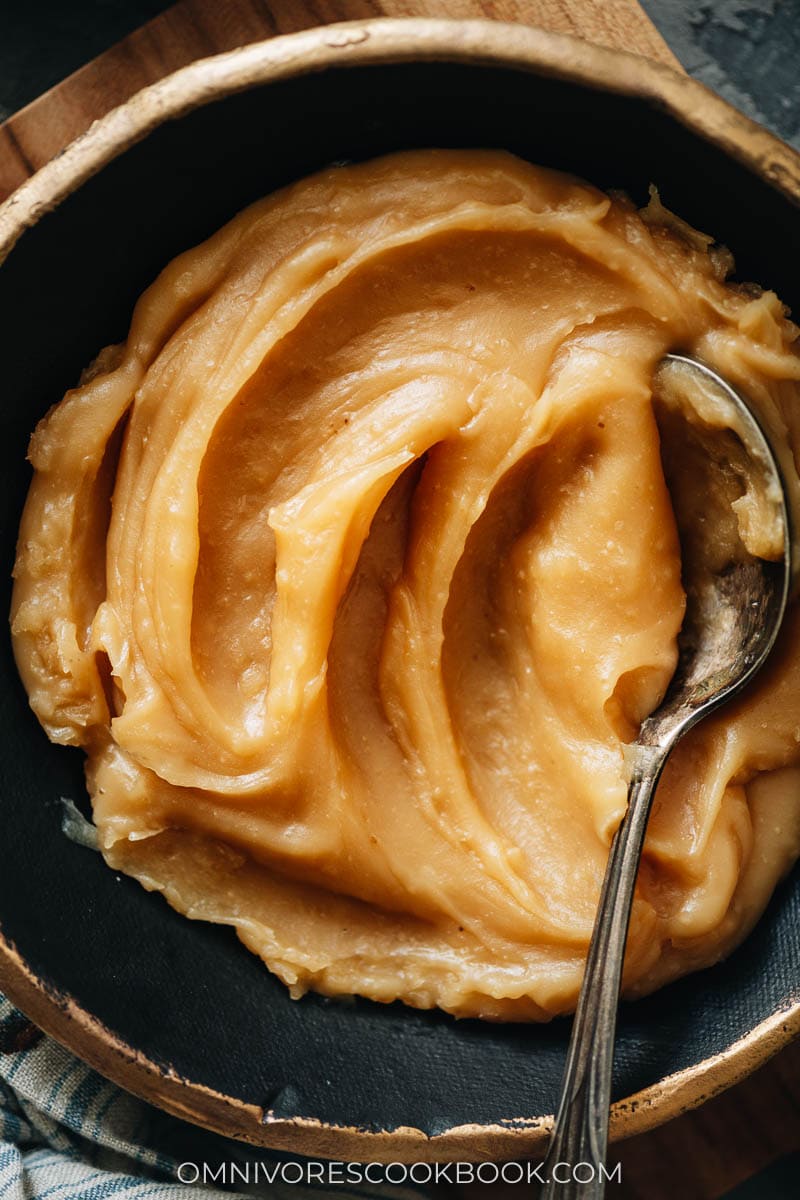
Why this recipe
I prefer my lotus seed paste homemade and I guarantee this one is on par with the quality at the best Chinese bakeries. It’s smooth and silky, and while it’s sweet, it’s not too sweet. It also has just a touch of a caramelized flavor and a gorgeous golden color.
The thing that set this recipe apart is the sugar.
1 – This recipe uses cooked sugar
Many online recipes skip the step of cooking the sugar. Yes, skipping it does simplify the process, but I’ve found this step is essential to creating a richer taste and getting that beautiful golden hue.
It might sound like a daunting task, but it’s incredibly easy if you follow the recipe. Without this step, your lotus seed paste will end up with a pale color that won’t look very appetizing in the mooncake.
2 – A bit of maltose make a difference
If you’ve ever tasted lotus seed pastry from a Chinese bakery, you may have found the texture of the filling to be very smooth and round. That’s the magic of maltose, a super thick syrup that is commonly used when making char siu pork. It also makes the lotus seed filling easy to shape and work with.
Asian markets usually carry it, but these days you can easily find it on Amazon.
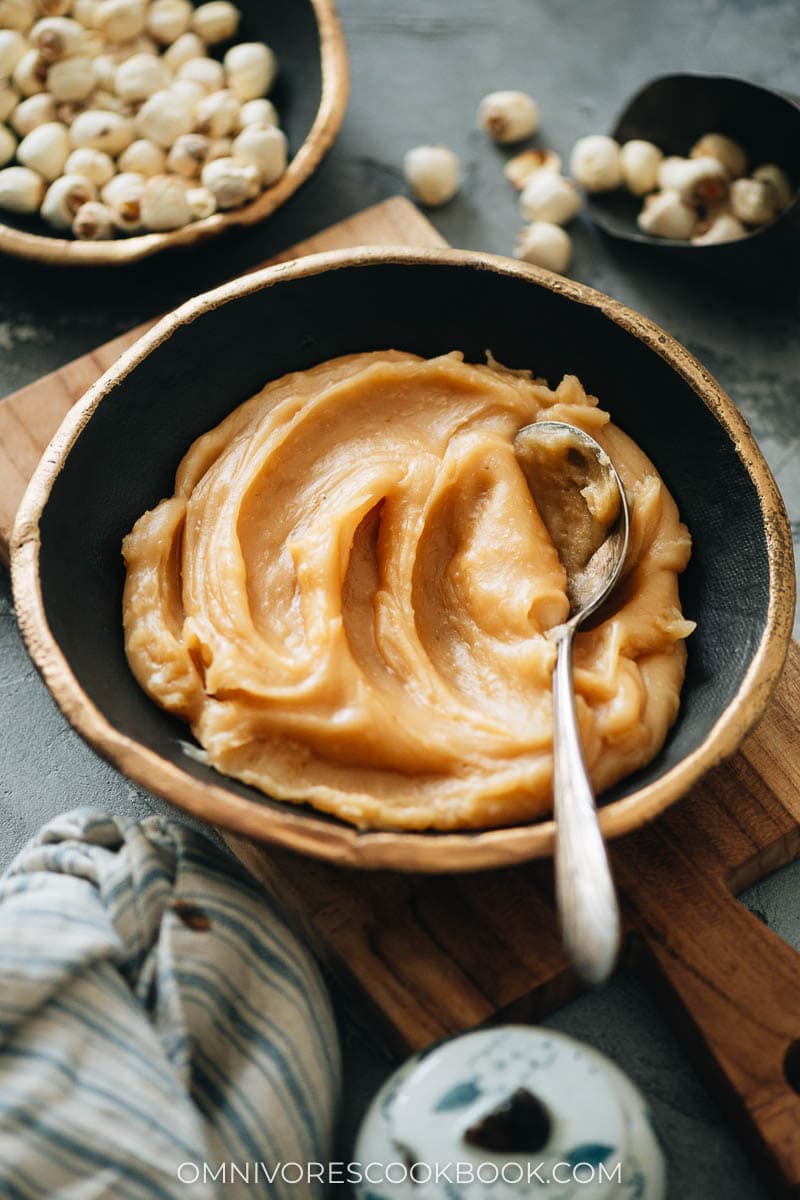
Cooking process
I know it sounds intimidating to make, but it only requires four ingredients. Follow the steps below and you’ll see how easy it is if you just follow the instructions.
1- Prepare the dried lotus seeds
- Soak the dried lotus seeds in water (prepare ahead of time)
- Once soaked, remove the hearts, which look like green stems. (They’re medicinal and taste bitter. In China people make tea with them, but you’ll need to remove them for this recipe)
- Cook the lotus seeds in an Instant pot or on the stovetop until tender
- Drain off the cooking liquid
- Blend the lotus seeds (with a blender or a food processor)
PS. Be careful when you’re blending the hot lotus seed paste. Always open the lid on the top of your blender or food processor to let the steam out while blending.
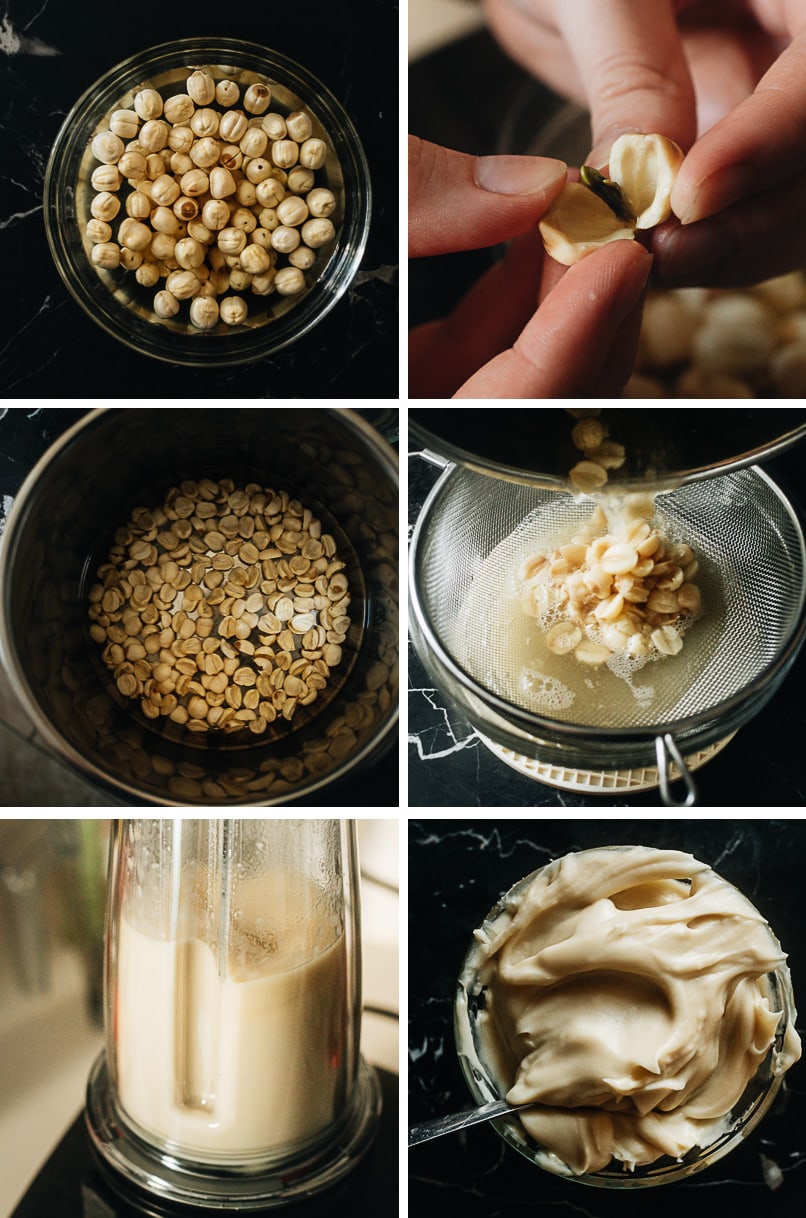
2 – Cook the blended lotus seeds
- Heat up the sugar with oil
- Wait until the sugar turns golden brown (no touching with your spatula!)
- Add the blended lotus seeds and sugar, cook, and stir
- Pour in the rest of the oil, a small amount at a time
- Add the maltose
- The lotus seed paste is done when the maltose is fully incorporated
NOTE: It’s very important to NOT stir the sugar while melting it to prevent crystallization.
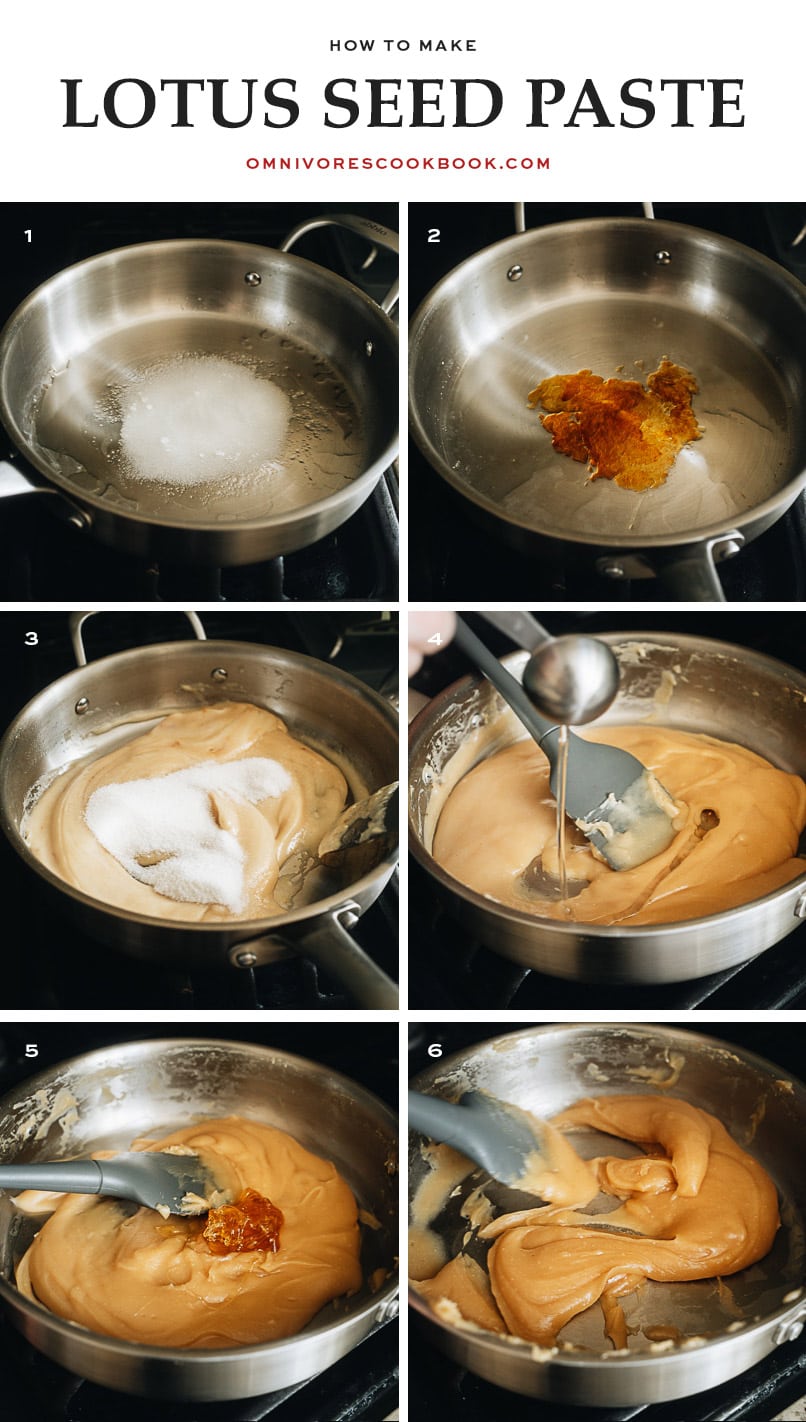
Afterthought
It takes some time and effort to make lotus seed paste at home, but it’s definitely worth it. It does not contain additives or preservatives, has a fresher taste, and is less sweet (you can easily control the level of sweetness).
Lotus seed paste can be made ahead of time. You can refrigerate or freeze it in small batches for later use, something I always do so that it’s a little easier each time to make my Chinese pastry treats.
My homemade lotus seed paste can be used to make so many wonderful things like mooncakes, mochi cakes, and other sweet Chinese pastries.
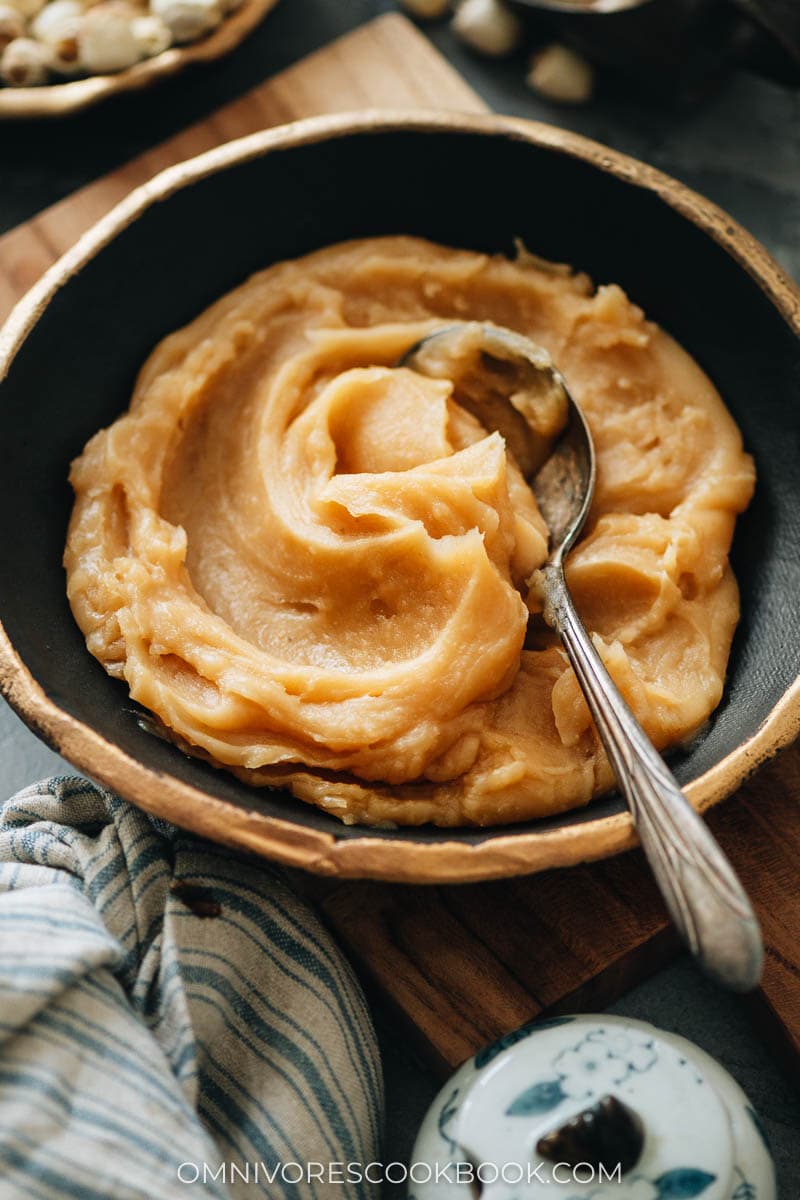
Want to learn more about Chinese Cooking? Sign up my newsletter to receive the 5-Day Chinese Cooking Crash Course and recipe update!
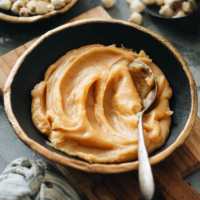
Homemade Lotus Seed Paste (莲蓉馅)
Ingredients
- 100 g (1 cup) dried lotus seeds
- 70 g (1/4 cup + 2 teaspoons) sugar
- 50 g (1/4 cup) vegetable oil
- 25 g (1 tablespoon) maltose
Instructions
Prep
- Rinse the lotus seeds, then cover them with 1 inch (2.5 cm) of water. Soak overnight (or at least 3 hours).
- Once rehydrated, drain and discard the water. Split each seed open with your hands, then remove and discard the green core if it has one.
Cook the lotus seeds
- Option 1 – Cook on the stove: Add the split seeds to a pot and cover with an inch (2.5 cm) of water. Bring to a boil over medium-high heat, then reduce to a simmer. Cook, covered with the lid slightly ajar (to prevent it boiling over), for 1 hour. The seeds are done when you can mash them with a fork and the water is milky. Keep an eye on the water level, as you may need to add more during the simmering.
- Option 2 – Cook in Instant Pot or a pressure cooker: Add the split seeds to the Instant Pot and cover with an inch (2.5 cm) of water. Cook at high pressure for 15 minutes. Let release naturally for 8 minutes, then use fast release.
- Drain the cooked seeds and add them to a food processor or blender. Add 1/3 to 1/2 cup boiling water. Blend until very even and smooth. Transfer to a bowl. (*Footnote 1)
Cook the lotus seed paste
- Add a quarter of the sugar and a quarter of the oil to a medium-sized stainless pan (*Footnote 2). Shake the pan so the sugar and oil spread out. Turn the heat to low and cook, swirling the pan occasionally, until the sugar turns a light amber color. Do NOT stir, which will cause the sugar to crystalize.
- Add the lotus seed puree and remaining sugar to the pan. Stir until the sugars and oil are incorporated into the puree.
- Raise the heat to medium-low and cook, stirring constantly, until the paste begins to dry, about 5 minutes.
- Begin incorporating the oil, a quarter at a time. Keep cooking and stirring until the oil is fully absorbed into the paste.
- Add the maltose (*Footnote 3). Stir and cook to dissolve it into the paste.
- Continue cooking until the mixture is pulling away from the pan and comes together as one piece, 6 to 10 minutes. The cooking time depends on your heat level and how much water you added while blending the lotus seeds.
- Remove the pan from the heat and let cool before using. The paste will thicken quite a bit after cooling down, which will make it easy to handle when you make mooncakes or other Chinese pastries.
Store
- Store the fully cooled lotus seed paste in a sealed container in the fridge for up to 1 week or in the freezer for up to 3 weeks.
Notes
- Depending on the blender or food processor you use, you might not be able to get a very smooth result. In this case, you can strain the paste to get a smoother texture.
- A stainless steel pan works the best and it’s easy to clean. I tried the recipe with a nonstick pan and somehow it didn’t work. A cast iron pan should work too, but it might be harder to clean.
- If your maltose is very tough and difficult to scoop, heat it in the microwave to warm it up slightly. Grease your spoon with some oil before scooping, so the maltose will come off the spoon easily.
Nutrition
If you give this recipe a try, let us know! Leave a comment, rate it (once you’ve tried it), and take a picture and tag it @omnivorescookbook on Instagram! I’d love to see what you come up with.
Other recipes for mooncakes and Chinese pastries
- Homemade Red Bean Paste
- Homemade Golden Syrup (转化糖浆, Invert Sugar Syrup)
- How to make Kansui
- The Ultimate Guide to Traditional Mooncake (传统广式月饼)
Lilja Walter is a part of the Omnivore’s Cookbook team and worked closely with Maggie to develop and test this recipe.













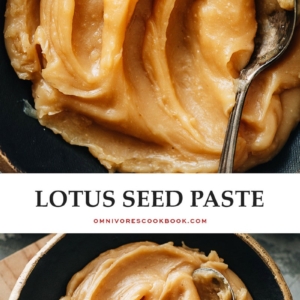
hi, im so amaze with all the details you put inside this writing, the details is super helpful and beautifully written, its like im reading a super pricey cookbook, LOL… however, could you share how long the pastes (lotusbean, redbean, blacksesame) can be kept in refrigerator? and how long if in fridge? if you know something about this let me know… Or maybe if you know how to indentified the spoiled paste? please share.
Im sending my gratitude to you for all the knowledge you write on mooncakes making, filling making, and all of them. its the most helpful essay i read, to be ready and prepare for what will happen in my kitchen… wkwkwkwk….
Yes, all the homemade paste can be stored in the fridge or freezer. To preserve the texture and prevent it from drying out, I would use plastic wrap tightly wrap the filling and store it in a ziplock bag (or container). As for the storage time, they should be able to stay well in the fridge for at least a week and 2 to 3 months in the freezer. If the paste looks fine (not moldy etc), the best way to test its freshness is to taste it. I would taste a very small piece and see if it’s gone stale or rancid, and spit it out if it doesn’t taste right.
Hi – can honey be used instead of maltose? Also if I double the recipe for the instant pot, is doubling the water sufficient?
You can, but the texture and the taste will turn out different. Yeah I think doubling water will be enough.
ah ah , amazing recipy. I will try it my home. water came in my tongue. Follow this recipe , will I success to make it.
Sounds good! Happy cooking and can’t wait to hear your feedback 🙂
This made a beautiful and smooth lotus seed paste for me! It was surprisingly easy. I’ll be using it in a mooncake recipe tomorrow!
Thank you very much for this wonderful lotus seed paste recipe. I have tried many ready make lotus seed paste and it’s always ended up very disappointing, either it is too sweet or its taste weird. Your recipe is very details and easy to follow , that’s most amazing and authentic lotus paste i have ever had .
I made this and it was perfect!
hi again, the sir recipe i did first from another source was a bit too runny thta i cannot roll them into balls. can i lessen the oil or add more paste to my existing batch to correct it so that it can hold its shape better or do i really have to start all over again? thanks the recipe calls for 300g lotus seed, 250g each sugar and oil and 30g maltose then i just added salt to balance all flavors. thanks
If the paste comes out too runny, you probably didn’t cook it long enough. I think add more paste might work but starting all over might be the best way to go.
Hihi.. I kept the lotus seed paste in the fridge and when I took it out 2 days later, the oil started to split from the paste. Tried to mix it back by kneading it but more oil came out instead. What should I do? Your advice will be greatly appreciated. 🥺
I’m afraid I don’t have a great answer because I haven’t come across this situation before.
I think it might be the best just to use the paste and drain the oil off if you cannot knead it back.
Thanks for the fantastic recipe with all the detailed explanations! very clear, very easy to follow. I made lotus paste twice now, although I cheated a bit: I used slightly less sugar (raw cane sugar once, yum!) and oil. turns out a little less smooth, but can still be formed into balls easily. I put some of the formed balls in ziplocks and freeze them, easy to use on demand later. they’re great in Japanese style mochi. everyone who tried one said they were addictive!
the recipe does come with a bit of work, though… it’s easy, but it takes some time. well worth it, though. I just love this lotus paste!